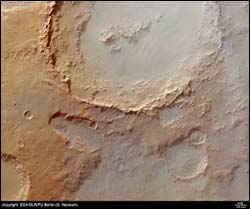Physics and Astronomy
This area deals with the fundamental laws and building blocks of nature and how they interact, the properties and the behavior of matter, and research into space and time and their structures.
innovations-report provides in-depth reports and articles on subjects such as astrophysics, laser technologies, nuclear, quantum, particle and solid-state physics, nanotechnologies, planetary research and findings (Mars, Venus) and developments related to the Hubble Telescope.

Extrasolar Planet News: Superplanet Or Brown Dwarf?
New observations of an oddball planetary system 150 light-years from Earth may force astronomers to rethink the textbook definition of a planet and the accepted idea about how such a body forms. The observations suggest that either some planets are superheavy or that planets can form from disks of gas and dust that encircle not just a single star but two starlike objects.
Two years ago, when astronomers at the Geneva Observatory in Sauverny, Switzerland, reported their findings on

Danish Researchers Break the Limits of the Internet
A team of Danish physicists has taken a crucial step towards an Internet that is faster and more secure than what we know today. The researchers from the Niels Bohr Institute at the University of Copenhagen have created an atomic memory that, in time, will be able to break the limits for Internet communication. The team’s breakthrough was published in the prominent journal, Nature, on 25 November 2004.
From Internet to Quantum Internet
The Internet is getting faster

‘Listen, two black holes are clashing!’
MiniGRAIL: first spherical gravitational wave antenna in the world
Since last week, Professor Giorgio Frossati of Leiden University’s Institute of Physics can ‘listen’ to gravitational waves. That is, if such a wave happens to come along. Gravitational waves originate from violent clashes between black holes in the universe and from instabilities in neutron stars.
MiniGRAIL is the name of the first spherical gravitational wave antenna in the world. The ball was made at t

Young Stars Poised for Production of Rocky Planet
VLT Interferometer Studies the Inner Region of Circumstellar Discs [1]
One of the currently hottest astrophysical topics – the hunt for Earth-like planets around other stars – has just received an important impetus from new spectral observations with the MIDI instrument at the ESO VLT Interferometer (VLTI).
An international team of astronomers [2] has obtained unique infrared spectra of the dust in the innermost regions of the proto-planetary discs around three young

The Changing Face of Space Robotics
Dr Eddie Moxey of the University of Surrey recently gave a speech at the IEE seminar on the Changing Face of Robotics. His speech concentrated on the use of robotics in space.
The talk reviewed the past, present and future of the two main strands of space robotics research and development On-Orbit Servicing (OOS) and Planetary Exploration.
Since the deployment of the Canadarm, on the Space Shuttle, OOS has steadily developed from a fascinating research topic into a po

Crater Hale in Argyre basin
These images, taken by the High Resolution Stereo Camera (HRSC) on board ESA’s Mars Express spacecraft, show Crater Hale in the Argyre basin of the southern hemisphere of Mars.
The images show an area close to the northern rim of the Argyre basin, located at latitude 36° South and longitude 324° East. The image was taken with a ground resolution of about 40 metres per pixel during Mars Express orbit 533 in June 2004.
Slight periodic colour and brightness variations in